How to apply Dorland’s wax medium on watercolor
February 17, 2014 2023-05-09 21:40How to apply Dorland’s wax medium on watercolor
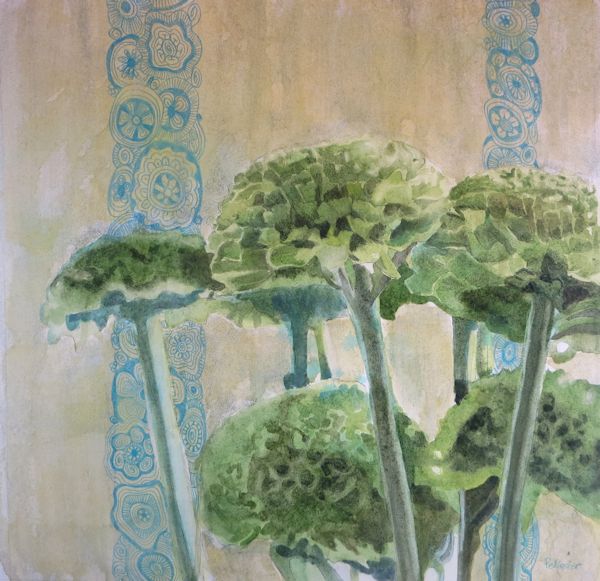
How to apply Dorland’s wax medium on watercolor
Applying Dorland’s wax medium on watercolor has many advantages, it will protect the paper from humidity and is easy and fast to apply, it also has a nice odor that is way less strong than varnish.
I recently did paint those green Chrysanthemums with watercolors and mixed media on paper and did mount the painting on a cradled panel.
You might also like: Mounting a watercolor painting on a cradled panel board, a step by step tutorial
Here is how to apply Dorland’s wax medium on watercolor
You will need:
- An already painted and dry watercolor painting mounted on board
- Krylon workable fixative
- Dorland’s wax medium
- A soft cloth
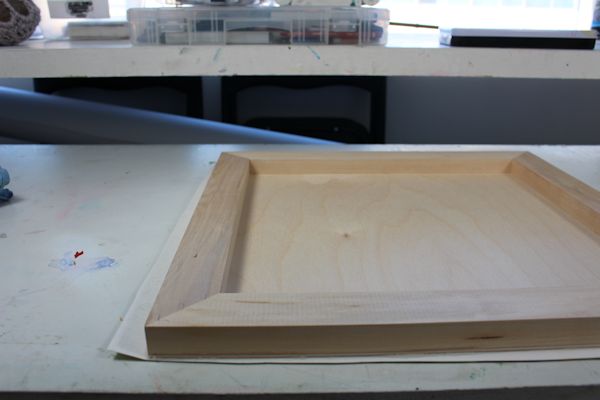
Here the watercolor painting had been mounted on board, you need to trim the extra paper on the sides before applying the finish.

Using a cutter that you hold parallel to the sides of the panel is the most convenient way to trim the excess paper on the sides.
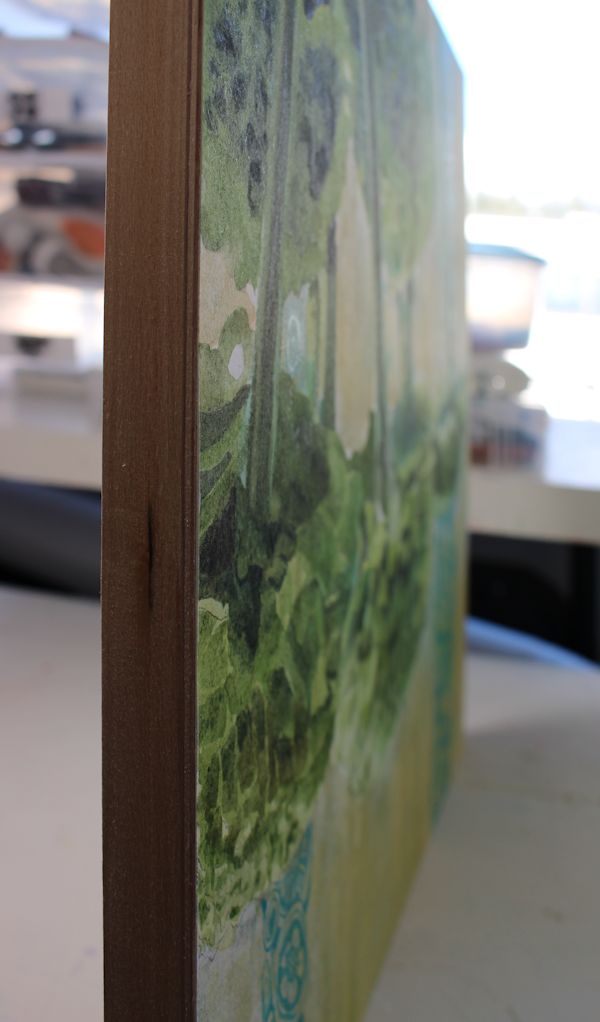
The sides are now neat. Depending on the media you used on your paper you might want to spray a bit of working fixative before applying the wax. I like to use Krylon workable fixative for that.
I am a Blick Art Materials affiliate and I receive a small compensation for sales. That does not effect in any way the cost of the purchaser’s order but it helps me keeping the content of this blog free.

 |
Krylon Workable Matte FixatifGives lasting protection to pencil, charcoal and chalk, yet erases easily. Clear, matte fixative is easy to work with. Dries in seconds, doesn’t wrinkle, smudge or smear. Spray can. |
In the case of this painting, the blue flowers designs in the background were drawn with colored pencil, rubbing wax on top of colored pencil would displace some of the pencil pigments and blur a bit the designs. Even if your painting is only watercolor, I recommend you spray a bit of fixative to make sure none of the watercolor pigment is disrupted by the dorland’s wax medium.

I am using Dorland wax medium that I will apply with a blue shop towel. You can buy those at home hardware stores, they have the advantage of not leaving any residue. A soft cloth would work as well.
I am a Blick Art Materials affiliate and I receive a small compensation for sales. That does not effect in any way the cost of the purchaser’s order but it helps me keeping the content of this blog free.

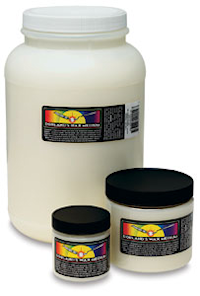 |
Dorland’s Wax MediumAdds translucency to oil paints, making them more brilliant. Also used as a final coat on dry paintings, metal sculpture, wood carvings, and antiques. May buff to gloss finish. Thins with turpentine. |
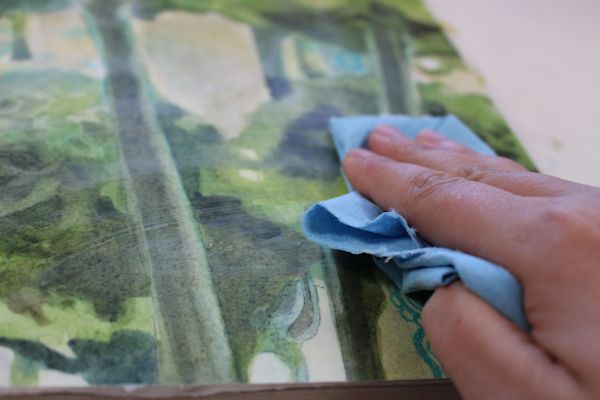
Next you can apply the wax, using circular motions, like you would do when applying wax on a piece of furniture.
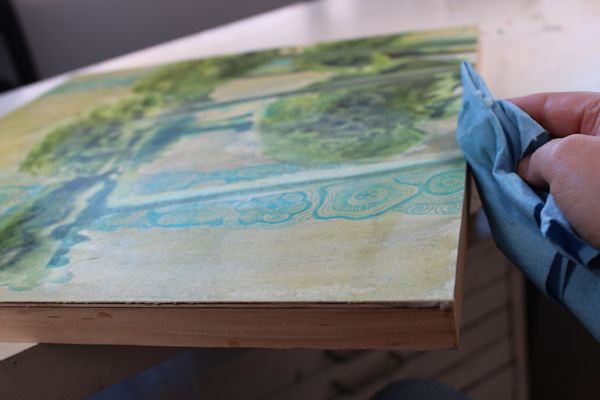
If your painting is mounted on wood, you can also apply the wax to the sides of the panel as well.

Looking at the looking at the surface of the painting held horizontally against the day light is a good way to check if you missed any area.
You can then leave the painting to dry for a few days and buff it with a soft cloth to make the finish more shiny.



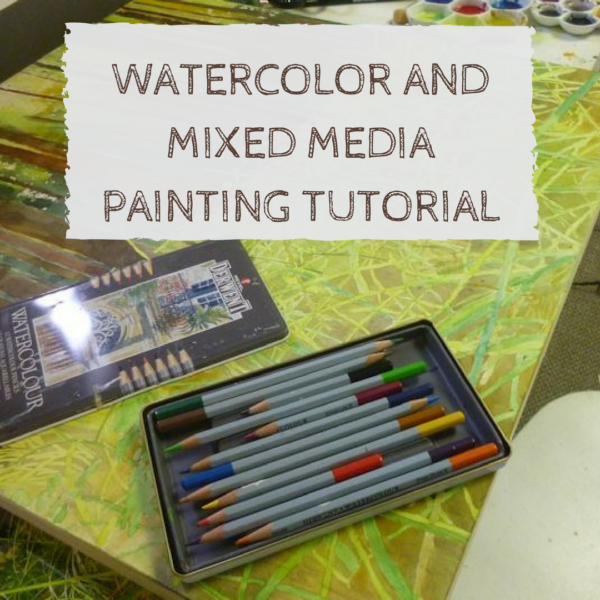
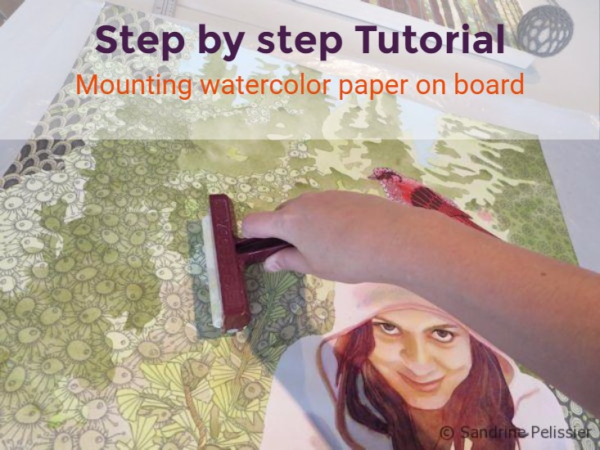

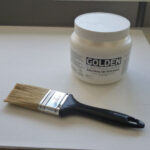

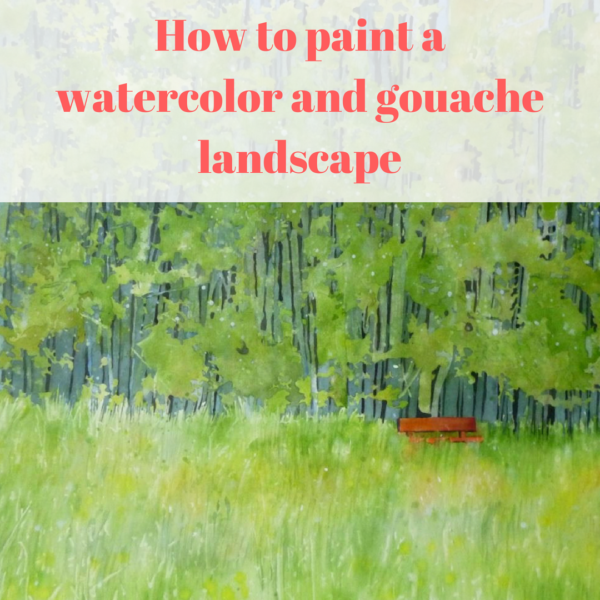

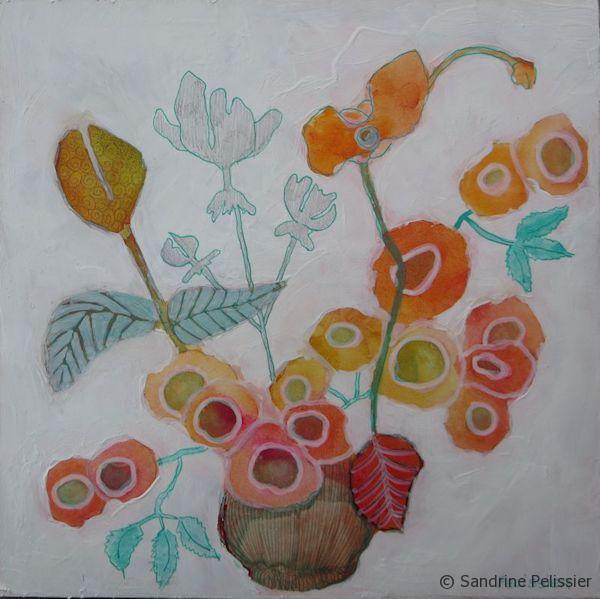








Comments (60)
Olga Spathis
Hi,
I just love working with watercolors and I have been teaching myself on my own. I don’t know what possessed me to use a wooden panel(like the one featured here). I am working on a watercolor painting and have literally added layer upon layer to get a rich effect (almost like oil painting!). I plan on finishing it off with a layer of wax over the water color. Can I do that? The color is on the wooden panel. I do hope I don’t lose this painting. I used finetec watercolors (golden type of colors)
Sandrine Pelissier
Hello Olga. From what I understand you painted directly on the wood panel? or did you mount paper on the panel.
I would recommend you use fixative (Krylon has a good fixative that can be sprayed) before doing anything and trying the wax on a small section of the painting to see if it doesn’t smudge the colors. Alternatively you could spray varnish, that might be the safest way to go about it.
Hope that helps 🙂
Susan J. Schmieding
So, can you apply the wax to a watercolor painting that is not mounted on anything ? I would prefer to mount to board but cannot afford that at this time. If I did apply wax to a watercolor painting and then sold a fairly large painting, is it ok to roll the painting to ship? Thank you so much for your information here. Susan
Sandrine Pelissier
Hello Susan and thanks for your question. Yes you could apply wax to a watercolour painting that is no mounted, but then you would have to display it framed I guess or mount it later. But if you display it framed you don’t really need the wax as the painting is protected by the glass.
I think it would be ok to roll it to ship, but would wait a day or two before doing that.
Ute Vaughn
How did you apply the watercolor paper on the board? Did you glue it down? What wood and what adhesive did you use? Thank you
Jen Palmiotto
Dear Sandrine,
Thank you for sharing this fantastic technique! I am trying it now for the first time and your instructions are so helpful. Do you use a drop in frame for your Watercolors on cradled panel board or paint the wooden sides? I am wondering if I just prefer them plain. Thank you for your response.
Sandrine Pelissier
Thanks Jen, I am actually applying wax on the sides of the panel. I also like to display the paintings in the simplest way.
Jen Palmiotto
Thank you, Sandrine. Any tips for getting wax out of clothes? Got some on my t-shirt by accident.
Sandrine Pelissier
I would think hot water and detergent should work, let me know if you find a different way 🙂
Sam
I appreciate to read all of the tips on wax. I am trying to find out if I need to spray a fixative Elon my mechanical pencil sketches before I apply watercolour to the page? If so would it be workable or permanent?
Thank you
Same
Sandrine Pelissier
Hello Sam,
I would not recommend spraying fixative on your drawing before painting with watercolor as it will change the surface of your paper and make it waterproof.
Painting tutorial: painting a forest with watercolors and gouache
[…] Read more about this technique here […]
Andrée Lachance
J’aime votre blog. Toujours de bonnes idées. J’ai été intriguée par un de vos blogs pour monter des peintures sur des supports de bois. Je viens de monter des peintures sur yupo de cette façon et j’aime le résultat. J’ai utilisé un vernis en aérosol Krylon avant de monter les peintures et des gros livres sur l’envers durant le séchage pour m’assurer d’une bonne adhésion.
I love your blog. Always interesting ideas. Following one of your blog ideas, I just tried mounting paintings on yupo on wood craddles and I like it. I used a Krylon spray varnish before mounting and heavy books on the upside down side to insure a good adhesion.
Sandrine Pelissier
Merci Andrée! Je suis très contente d’apprendre que vous aimez lire le blog et que vous avez bien aime le résultat en montant le papier yupo sur du bois 🙂
Sandy
Can you apply a wax coating to an oil painting?
Sandrine Pelissier
I would think so but I am not painting with oils so I never tried it.
Dsb
Not at all. Do not even try it.
Oil paint must be allowed to breathe, since the oil that binds the pigments together takes some good time to dry. You do not want to create a film on top of the surface which will trap the oil and fumes on the inside. It’ll mess up your piece.
ev
You can absolutely seal oil paintings with Dorland’s wax. I use only that to seal my oil paintings instead of varnish. Google the product.
Brenda elaine shirvis
So glad I found you on Pinterest!
Sandrine Pelissier
Thanks Brenda 🙂
Sharleen Field
Love your work! My only concern is – does the wax yellow with age?
Sandrine Pelissier
Thanks Sharleen,
I didn’t notice any yellowing of wax with age. As long as you keep your artwork away from strong direct sunlight I don’t think wax would yellow more than varnish does.
bonnie nelms
would this same procedure apply to watercolor on YUPO…would it be safe to display/sell without frame? wc on yupo makes me nervous because it lifts so easily.
thanks for your reply.
Sandrine Pelissier
On yupo I would recommend varnishing with a spray varnish or a soft brush and not apply wax.
How to finish and display your mixed media paintings on paper : A few options
[…] Read more here on applying a wax finish to a watercolor painting. […]
Debbie Kilmer
Where can I purchase this wax for watercolor paintings? Is this a product in art and craft stores, such as Hobby Lobby or Michaels stores? What other ways can a watercolor painting be finished to make the colors of the painting “pop”? In the past, I have been a painter with acrylics, and always used a varnish….so what would work for watercolors without the shine or gloss of a varnish? Thank you for your help.
Sandrine Pelissier
You can buy the wax at many art supplies store and I think I have seen it at Michael, you could also buy it online, this is the wax I am using: https://store.opusartsupplies.com/sagro/storefront/store.php?mode=showproductdetail&product=17940
You can look at this post for a few finishing ideas for your paintings: https://paintingdemos.com/how-to-finish-and-display-your-mixed-media-paintings-on-paper-a-few-options/
Alex
I have just read the above on waxing a finished watercolor painting. I have used the Dorland wax with success. There is also another wax medium that can be used in replacement of Dorland, that is, Gamblin cold wax medium. This is a beeswax and OMS mixture. Steven Berry has used this product instead of Dorland.
Thanks for sharing your technique. Love your blog
Alex
Sandrine Pelissier
Thanks Alex
Lisa Gibson
I love using the Dorland’s Wax also due to the low odor. The only thing that is sometimes a bother is the cloth marks on the painting. Are you able to buff those out later?
Sandrine Pelissier
Yes, I would try to minimize them when applying the wax, and then buff them later. Maybe use a bit less wax too.
ginimom21770600
What type of wood do you use to mount your watercolours? Do you pick it up at a hardware store?
I want to stay away from glass and frames as much as possible so finding your process really made me happy.
Gini
Sandrine Pelissier
Thanks Gini:)
I am lots of trouble with frames, damages on the corners, broken glass, etc… so I am trying to avoid framing as much as possible.
I am using a cradled panel that I am buying at Opus, but if you are good with woodworking, it is quite simple to make:
https://store.opusartsupplies.com/sagro/storefront/store.php?mode=browsecategory&category=147
Marcy LaBella
Cradled boards come in every size and are very inexpensive – you probably can’t make them for what they cost to buy. They are super nice to work with come sanded and ready to go. Can’t say enough about them they are great for acrylics, oil painting or mixed media.
Leslie Dalton
Thank you for your info on waxing the painting. The wait time to buff was my query. I do mount my watercolor painting on artist panels with cradles as well. I fix my watercolor before starting the process and I turn the painting upside down to dry after mounting them and stack heavy book over the whole panel overnight. When I trim the overlap, it’s upside down on a mat and I trim the excess with an exacto knife. I love your art! 😀
Sandrine Pelissier
Thanks Leslie:) Turning the painting upside down and put weights on top is a very good idea!
I am waiting about one day before buffering the wax finish.
CheyAnne Sexton
Thanks again for all the wonderful and helpful info. Really liked the part about using the fixative to stop any art process from blurring and moving.
Sandrine Pelissier
Thanks CheyAnne!
Protéger une estampe avec de la cire froide | Louise Lamirande
[…] d’abord, merci à l’artiste et blogueuse Sandrine Pelissier qui, par cet excellent tutoriel (en anglais), m’a donné le goût de tester l’effet de la cire froide sur mes estampes […]
Exterior Home Painting Denver CO
Hey are using WordPress for your blog platform? I’m new to the blog
world but I’m trying to get started and create my own. Do you require any coding knowledge to
make your own blog? Any help would be really appreciated!
Sheri Trepina
Really enjoy your work!
What are your thoughts about UV protection for the watercolours with this technique?
Thanks for all the wonderful information and techniques you share with us.
Sheri
Sandrine Pelissier
Thanks Sheri:)
I might be wrong but I don’t think the wax has any UV protection. This is the same though if a traditional watercolor painting is framed without UV protection glass.
Wendy
Beautiful work, Sandrine.
Must try this technique. I am looking online for Dorland’s wax – do you use the Jacquard brand? Is the finish fairly matte?
Thanks
Sandrine Pelissier
Thanks Wendy. This is the wax I am using: https://store.opusartsupplies.com/sagro/storefront/store.php?mode=showproductdetail&product=17940
The finish is fairly matte but you can make it a bit shinier by buffing it with a soft cloth.
Li
I was wondering if it is necessary to use workable fixative prior to waxing? Would final fixative make too much of a non-permeable surface or does the wax remain on top? Thank You.
Sandrine Pelissier
I used workable fixative here mainly because of the colored pencils which are also made with wax I believe. Testing on another piece of paper, I saw that the wax would disrupt the colored pencil design.
Sometimes I spray fixative also to make sure that a watercolor paint pigments don’t move as well, but that is mostly when I brush on the varnish, I don’t think wax will disturb the watercolor pigments as much as brushed on varnish.
Arthur F. Coitinho
Very interesting technique. Enjoyed. You could tell that another brand or type of wax could be used without the wax Dorland?
Thanks for the opportunity.
Sandrine Pelissier
Hello Arthur, I am not sure what other brand will be available depending on where you live but Dorland’s is the most popular by far. May I ask why you would like a different brand?
I think some of the wax medium here for example would work the same way: http://www.michaelharding.co.uk/news5.php
Arthur F. Coitinho
Hi, Sandrine!
Thanks for the reply. I do not like to have a different brand, but I live in Brazil and here there is no Dorland wax to buy. We can get through Amazon via online. Here we find other brands that are also composed of beeswax with some other component.
De la poudre de marbre sur Yupo | Louise Lamirande
[…] parlant d’encadrement et de couche de verre, j’ai appris, sur le blog de l’artiste Sandrine Pelissier, qu’il est possible de protéger les aquarelles à l’aide d’un médium à cirer et […]
mary
Thank you for sharing I might give this a try
Sandrine Pelissier
Thanks Mary 🙂
Anita Goodson
Love everything you do.
Sandrine Pelissier
Thanks Anita!
Anita Goodson
Love everything you do. I wanted to download the 34 pg. & can’t. I am already signed up so it wouldn’t let me. Can you give me directions?
Thanks,
Anita
Sandrine Pelissier
Hello Anita, I am sending you an email with a link to access the PDF.
Judy
Beautiful work!
Curious, what did you use for the blue entangle pattern? Marker or ink? and in what stage did you apply it?
Sandrine Pelissier
Hello Judy,
Thanks:)
I have the step by step tutorial for this painting scheduled for in two weeks. You will see all the steps I took. I did draw the blue zentangle patterns with colored pencils.
Louise
Très intéressante cette technique. Selon votre expérience, est-ce que la cire laisse un résidu collant? Est-ce suffisant pour protéger à long terme une aquarelle?
Merci à vous,
Louise
Sandrine Pelissier
Merci Louise 🙂
La cire est collante au debut mais apres deux ou trois jours, elle est seche et a perdu cet aspect collant. C’est a ce moment la qu’on peut la faire briller avec un chiffon doux.
Je pense que la cire offre une bonne protection surtout un bonne etancheite a l’eau, la principale difference avec le vernis est que le vernis content des filtres uv que la cire n’a pas, mais je ne suis pas sure de l’efficacite de ces filtres UV de toutes facons.